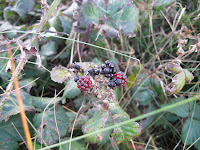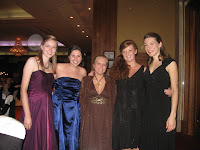 We started by cutting the pumpkin into chunks and cutting off the stringy inside part. If you've never cut up a pumpkin before, think of it as a cantaloupe. When you slice it, you have to make sure you cut off the part with the seeds before you serve it; it's the same case here. At this point you can cut off the skin as well, though I find it's much easier to wait until after you cook them.
We started by cutting the pumpkin into chunks and cutting off the stringy inside part. If you've never cut up a pumpkin before, think of it as a cantaloupe. When you slice it, you have to make sure you cut off the part with the seeds before you serve it; it's the same case here. At this point you can cut off the skin as well, though I find it's much easier to wait until after you cook them.  Next, boil the pumpkin until it's soft, just as you would if you were making mashed potatoes. You know they are done when you can easily put a fork into the pieces (though the skin will never be that soft). The longer you cook the pumpkin, the more "meaty" it will become. It just depends on how you want your pumpkin pie to taste. The size of the chunks also depends on how long you will need to boil them. Again, the same as if you were making mashed potatoes.
Next, boil the pumpkin until it's soft, just as you would if you were making mashed potatoes. You know they are done when you can easily put a fork into the pieces (though the skin will never be that soft). The longer you cook the pumpkin, the more "meaty" it will become. It just depends on how you want your pumpkin pie to taste. The size of the chunks also depends on how long you will need to boil them. Again, the same as if you were making mashed potatoes. Chances are, you won't be able to fit all the pieces into your pot. For our small pumpkin it took 5 times, so Michael and I had some candy corn his grandmother and my aunt sent over in a package. (They don't sell it over here.) It helped get us in the Thanksgiving mood while we waited for the pumpkin to boil.
Chances are, you won't be able to fit all the pieces into your pot. For our small pumpkin it took 5 times, so Michael and I had some candy corn his grandmother and my aunt sent over in a package. (They don't sell it over here.) It helped get us in the Thanksgiving mood while we waited for the pumpkin to boil. I also set aside the seeds. When I was a little girl, my mom would always bake the pumpkin seeds while my dad handled the dangerous carving before Bradley and I were old enough to be able to use knives. We loved them when we were kids, so I washed them and set them aside to cook for later. (I made them with 1 tablespoon of butter, salt, and pepper, and cooked them at 150°C / 300°F for about 25 minutes - they were delicious.)
I also set aside the seeds. When I was a little girl, my mom would always bake the pumpkin seeds while my dad handled the dangerous carving before Bradley and I were old enough to be able to use knives. We loved them when we were kids, so I washed them and set them aside to cook for later. (I made them with 1 tablespoon of butter, salt, and pepper, and cooked them at 150°C / 300°F for about 25 minutes - they were delicious.) Once the pumpkin is tender, set it aside to cool for about 10 minutes or until you can comfortably hold it. The skin should peal off easily with a knife. Discard the skin and put the pealed, boiled pumpkin into a bowl to be mashed. Don't worry if the pumpkin seems much more watery than the pumpkin you normally use from a can; it should be. Most recipes that call for pumpkin will require you to heat it up before using it anyway, so you can cook out the excess water. If you don't plan on heating the pumpkin, you can freeze and then thaw it. It will help to separate out some of the water, though not all. You can also purchase cheese cloth and strain the pumpkin through that. I wasn't that picky and we had to cook the pumpkin for pie anyway, so we didn't worry about the extra water.
Once the pumpkin is tender, set it aside to cool for about 10 minutes or until you can comfortably hold it. The skin should peal off easily with a knife. Discard the skin and put the pealed, boiled pumpkin into a bowl to be mashed. Don't worry if the pumpkin seems much more watery than the pumpkin you normally use from a can; it should be. Most recipes that call for pumpkin will require you to heat it up before using it anyway, so you can cook out the excess water. If you don't plan on heating the pumpkin, you can freeze and then thaw it. It will help to separate out some of the water, though not all. You can also purchase cheese cloth and strain the pumpkin through that. I wasn't that picky and we had to cook the pumpkin for pie anyway, so we didn't worry about the extra water.After Michael mashed up the pumpkin, we had more than enough to make the pie. We followed a basic recipe, though we had to substitute often for ingredients that were hard to find or too expensive. (Sorry cloves and ginger, we would never use you again.)
I took the pie to the Rotary meeting the day before Thanksgiving. Despite initial reluctance to try it (they thought the idea of making a dessert out of a gourd sounded gross), a few brave Rotarians had a piece, and with their endorsement the rest joined in. It was a success! I had made enough pie for each Rotarian to have 2 pieces, though I assumed most would only have one. I planned on taking the rest to a Thanksgiving party the next day, but by the end of the meeting there were only a few small pieces left. Luckily, the small pumpkin made enough for 2.5 large jars even after I made the pie, so I think we'll have enough to make some more.
Here is the general recipe I used, though I just eyeballed most of the measurements:
2 cups of pumpkin
1/4 cup brown sugar
1/2 cup sugar
1 cup cream
1/2 can of evaporated milk (85 g)
1/2 can of condensed milk (200g)
1.5 teaspoons ground cinnamon
1.5 teaspoons ground nutmeg
2 eggs
1 egg yolk
I also added 5 oz of cream cheese that I had in the refrigerator and didn't know what else to do with.
For the crust, we crushed up plain digestives until they filled the bottom of the pan and added about half a cup of butter, a little cinnamon, nutmeg, and brown sugar, and baked it until it turned brown. For the filling, I heated the pumpkin and sugars on the stove, then mixed the rest of the ingredients separately while the water evaporated out of the pumpkin. Once it was ready, I poured the pumpkin/sugar mixture into the mixing bowl and stirred before adding it to the crust.

















































